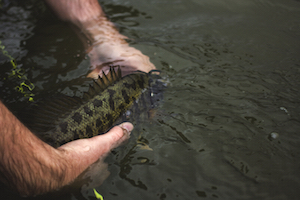Smallmouth Bass Winter Fishing

When the first cold weather of the year sets in Smallmouth Bass migrate to deep holes with little current in streams or deeper into the lake between 20 to 40 feet/6 to 12 meters deep.
There’s a mistaken belief that Smallmouth Bass fishing doesn’t start until the dogwoods and redbuds bloom in spring. However when a warming trend increases air temperatures to 50°F or more for at least 3 days, the Smallmouth Bass fishing season begins. This extends as far north as the Kentucky streams located in the southern United States.
Usually the pattern starts during the last week of February or the first week or two of March, leading up to the spring season. In a year with a mild winter it be as early as the second week of February. However this change has started as early as January in the last 10 years as global temperatures have risen.
- To catch Smallmouth Bass during this time you have to first find them. This can be done if you know where their winter lairs are. You’ll find lots of tools that can help in this regard. Sonar devices, especially two band 8-bit grey scale models are essential when fishing unfamiliar bass habitats.
- In the smaller Kentucky streams a winter hole may only be 4 to 6 feet deep. They spend the winter in these holes in a semi-dormant state until the first warm weather arrives in front of late winter or early spring.
The warm front draws the Smallmouth Bass to feed in the flowing water at the beginning or end of the wintering hole. Stream based Smallmouth Bass survive in a harsh environment and feeding opportunities are rare in the cold months.
The big females, especially, must take advantage of any food offered by nature at this time of the year to nourish the eggs in their bellies.
Ice Fishing for Smallmouth
Fishing for Smallmouth Bass closes for the winter in many parts of North America. Some seasons close as late as the end of February and open as early as May. Each state and province will have it’s own fishing season. This largely depends on climate. Even if your state or province permits ice fishing or winter fishing for Smallmouth, please practice catch and release to keep the population of the smallmouth bass strong.
Ice fishing techniques are pretty much the same for all fish species as a 6 inch hole doesn’t allow for a lot of movement on the line. The key is choosing the right jig.
There are 3 main types: horizontal, ventricle and 45°F/7°C jigs.
- Horizontal jigs sit in the water with the body and hook in the horizontal position
- Vertical jigs sit vertically
- 45°F/7°C jigs sit at a slant
Keep a small collection of each of these. Some popular ones to try include: JB’s Hot Head, Lindy’s Genz Worm for horizontal; Jig-a-Whopper’s tiger willow, and Lindy’s Frostee for Vertical; HT’s Blood Worms and the Denz Bug for 45°F jigs.


